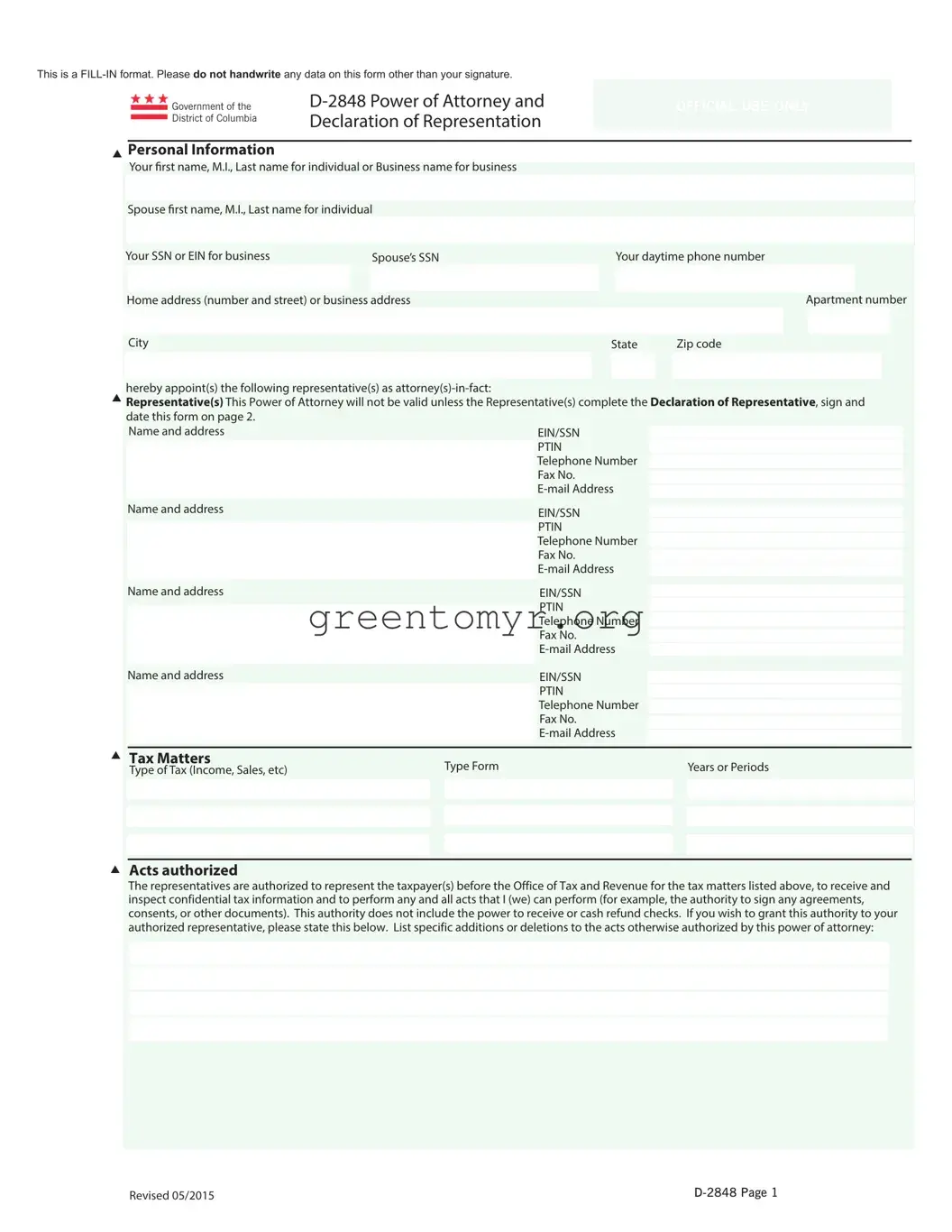Taxpayer's SSN or FEIN |
|
Taxpayer's Name |
|
|
|
|
|
|
|
|
|
|
|
|
|
|
|
|
Retention/revocation of prior power(s) of attorney By filing this power of attorney form, you automatically revoke all earlier power(s) of attorney on file with the Office of Tax Revenue for the same tax matters and years or periods covered by this document.
If you do not want to revoke a prior power of attorney, check here:
You must attach a copy of any Power of Attorney you want to remain in effect.
Signatures
Signature of taxpayer(s) If a tax matter concerns a joint return, both husband and wife must sign if joint representation is requested. If signed by a corporate officer, partner, guardian, tax matters partner, executor, receiver, administrator, or trustee on behalf of the taxpayer, I certify that I have the authority to execute this form on behalf of the taxpayer. If other than the taxpayer, print the name here and sign below.
Your Signature |
|
Date |
|
Title if other than individual |
|
|
|
|
|
|
|
|
|
|
|
|
|
|
|
|
|
|
|
Spouse's signature if filing jointly |
|
Date |
|
|
|
|
|
|
Telephone number if other than the taxpayer |
|
|
|
|
|
|
|
|
|
|
If not signed and dated, this power of attorney will be returned
Declaration of Representative Representative(s) must complete this section and sign below.
Under penalties of perjury, I declare that:
As the authorized representative of the taxpayer(s) identified for the tax matter(s) specified herein; I am one of the following:
a.A member in good standing of the bar of the highest court of the jurisdiction shown below.
b.A Certified Public Accountant duly qualified to practice in the jurisdiction shown below.
c.An Enrolled Agent under the requirements of Treasury Department Circular # 230.
d.A bona fide officer of the taxpayer’s organization.
e.A full-time employee of the taxpayer, trust, receivership, guardian or estate.
f.A member of the taxpayer’s immediate family (i.e., spouse, parent, child, brother, or sister).
g.A general partner of a partnership.
h.Student Attorney or CPA- receives permission to represent taxpayers before the IRS by virtue of his/her status as a law, business, or accounting student working in an Low Income Taxpayer Clinic or Student Tax Clinic Program.
i.Other 
Designation- |
|
Licensing jurisdiction (state) |
Bar, license, certification, |
|
|
|
|
|
|
Insert above |
|
or other licensing authority |
registration, or enrollment number |
|
Signature |
|
Date |
|
|
letter (a-i) |
|
(if applicable) |
(if applicable) |
|
|
|
|
|
|
|
|
|
|
|
|
|
|
|
|
|
|
|
|
|
|
|
|
|
|
|
|
|
|
|
|
|
|
|
|
|
|
|
|
|
|
|
|
|
|
|
|
|
|
|
|
|
|
|
|
|
|
|
|
|
|
|
|
|
|
|
|
|
|
|
|
|
|
|
|
|
|
|
|
|
|
|
|
|
|
|
|
|
|
|
|
|
|
|
|
|
|
|
|
|
|
|
|
|
|
|
|
|
|
|
|
|
|
|
|
|
|
|
|
|
|
|
|
|
|
|
|
|
|
|
|
|
|
|
|
|
|
|
|
|
|
|
|
|
|
|
|
|
|
|
|
|
|
|
|
|



